Task management is key to getting things done – whether you’re a student, a working professional, or just trying to stay on top of life’s demands. It helps you reduce stress and stay organized, so you can focus on what really matters. By taking a systematic approach and prioritizing your tasks, you can make progress towards your goals and achieve greater success in all areas of your life.
Life moves fast these days. There’s always so much to do and it can be really hard to keep up. That’s why task management is such a valuable tool. It helps you stay on top of your to-do list and make progress towards your goals.
If you want to get serious about task management, you need to take a systematic approach. That means identifying your tasks, prioritizing them, creating a task list, breaking down complex tasks, setting deadlines, and regularly reviewing and adjusting your task list. It may sound like a lot, but trust us, it’s worth it. Once you get the hang of it, you’ll be amazed at how much you can accomplish.
So let’s dive in and learn how to master the art of task management!
What is Task Management?
Task management is all about getting things done! It’s about overseeing tasks from start to finish, making decisions on the fly, and adapting to changes as they happen. When you’re managing tasks effectively, you’re on top of everything, from budget and time to scope and resources. You’re making sure that everything gets done efficiently and effectively. It’s a skill that can be learned, and with practice, you’ll be able to tackle any project with ease!
Project Management vs Task Management
Project management and task management are two related but different things. Essentially, project management is all about managing a specific project from start to finish, while task management is more focused on managing individual tasks within a project.
For example, let’s say you’re working on a big project at work. You’ll need to use project management skills to plan out the project, figure out what tasks need to be done, and coordinate with your team to make sure everything gets done on time. Task management, on the other hand, would involve breaking down those big tasks into smaller, more manageable tasks and making sure each one gets completed on time.
Another key difference between project management and task management is that project management requires you to see the big picture. You need to be able to look at all the different tasks and components of the project and figure out how they all fit together. Task management, on the other hand, is more focused on the nitty-gritty details of getting individual tasks done.
Both project management and task management require good team management skills to make sure everything gets done on time and on budget. But project management is generally more complex and involves managing multiple projects at once, while task management is more focused on individual tasks within a project.
How to Effectively Management Tasks?
Step 1: Identify your tasks
The first step in effective task management is to identify all the tasks that you need to complete. This can include work-related tasks, personal errands, household chores, and anything else that requires your time and attention.
One helpful tip is to write down all your tasks in one place, such as a notebook or digital task manager. This can help you get a clear picture of everything that needs to be done and avoid forgetting important tasks.
Step 2: Prioritize your tasks
Once you have identified your tasks, it is important to prioritize them. One effective way to do this is to use the Eisenhower Matrix, which categorizes tasks based on their urgency and importance. This can help you focus on the tasks that are most critical and avoid wasting time on tasks that can wait.

The Eisenhower Matrix involves dividing your tasks into four categories: urgent and important, important but not urgent, urgent but not important, and neither urgent nor important. By doing this, you can focus your time and energy on the tasks that are most critical and avoid getting bogged down by less important tasks.
Step 3: Create a task list
After prioritizing your tasks, create a task list. This can be a simple to-do list on paper, a digital task manager, or a combination of both. Be sure to include all the tasks you identified in step 1, as well as any deadlines or due dates.
When creating your task list, it can be helpful to break down your tasks into smaller, more manageable tasks. This can make it easier to tackle complex tasks and help you make progress towards your goals.
Step 4: Break down complex tasks
If you have complex tasks on your list, it can be helpful to break them down into smaller, more manageable tasks. This can make them less overwhelming and easier to tackle.
For example, if you have a task to “organize the garage,” you could break this down into smaller tasks such as “sort through items in the garage,” “donate or sell unwanted items,” and “organize remaining items in the garage.” By breaking down a complex task into smaller tasks, you can make it more manageable and increase the chances of completing it successfully.
Step 5: Set deadlines
Setting deadlines can help you stay on track and ensure that you complete your tasks on time. Be sure to set realistic deadlines that take into account your other commitments and obligations.
When setting deadlines, it can be helpful to use the SMART criteria, which stands for Specific, Measurable, Achievable, Relevant, and Time-bound. This can help you set realistic and achievable deadlines that are aligned with your goals.
Step 6: Review and adjust your task list
Regularly reviewing and adjusting your task list can help you stay organized and ensure that you are making progress towards your goals. Make sure to cross off completed tasks, add new tasks as needed, and adjust deadlines if necessary.
One helpful tip is to review your task list at the end of each day and plan your tasks for the following day. This can help you start each day with a clear plan of action and avoid getting overwhelmed by your to-do list.
By following these six steps, you can master the art of task management and achieve greater productivity and success in all areas of your life. Effective task management is a skill that can be learned and developed over time, and with practice, you can become a master of your to-do list and achieve your goals with ease.
Using Task Management Tools
There are a variety of task management tools available that can help you stay organized and on top of your to-do list. Below are some popular options:
- Notion: A powerful all-in-one workspace that includes task management, note-taking, and team collaboration features. It allows users to create custom databases, boards, and lists to manage their tasks and projects.
- monday.com: A visual task management tool that allows users to create custom workflows, set deadlines, and track progress towards goals. It includes features such as task dependencies, integrations with other apps, and customizable templates.
- ClickUp: A comprehensive task management tool that includes features such as time tracking, project management, and team collaboration. It allows users to create custom task lists, set reminders, and track progress towards goals.
- Trello: A popular Kanban-style task management tool that uses boards and cards to organize tasks and projects. It includes features such as checklists, due dates, and team collaboration.
- Todoist: A simple and intuitive task management tool that allows users to create custom task lists, set reminders, and track progress towards goals. It includes features such as task priorities, labels, and integrations with other apps.
Monday.com is the best cloud-based project management tool that helps teams manage their workflow and collaborate more effectively. It provides a visual overview of your team's progress, making it easy to identify bottlenecks and areas for improvement. It's a great option for teams looking for a flexible and intuitive project management solution.
- User-friendly interface that allows for easy task and project management
- Customizable templates for various industries and functions
- Integration with popular apps like Slack, Google Drive, and Trello
- Visual overview of team progress and project status
- Flexible and intuitive project management solution
Task management tools are a lifesaver! With these tools, you can create task lists, set deadlines, assign tasks to team members, and track progress towards your goals. They even come with features such as reminders, notifications, and integrations with other apps and services.
When choosing a task management tool, make sure to consider your specific needs and preferences. Some tools work better for individual use, while others are designed for team collaboration. You’ll also want to think about factors such as cost, ease of use, and available features.
By using a task management tool that works for you, you can streamline your workflow, stay organized, and achieve greater success in all areas of your life. So go ahead, find the tool that works for you and start crushing those tasks!







